Before we fall
Cello Concerto
Commissioned by San Francisco Symphony, Iceland Symphony Orchestra, Helsinki Philharmonic Orchestra, Odense Symphony Orchestra and BBC Radio 3. First performed by San Francisco Symphony and Johannes Moser (cello), conducted by Dalia Stasevska on 15 May 2025 at Davies Symphony Hall, San Francisco, CA.
Duration: c. 26 minutes
Instrumentation
2 Flutes
Alto Flute
Cor Anglais
2 Clarinets in Bb
Bass Clarinet in Bb
2 Bassoons
Contrabassoon
4 Horns in F
2 Trombones
Tuba
Percussion (2 players):
1: T hunder Sheet
Large Tam-tam
Large Bass Drum
2: T hunder Sheet
Large Tam-tam
Large Bass Drum
Strings: Suggested division:
ISSUU version for perusal only
Violin I i: 4 desks; Violin I ii: 4 desks (min. 3)
Violin II i: 4 desks (min. 3); Violin II ii: 3 desks
Viola I: 3 desks; Viola II: 3 desks (min. 2)
Violoncello I: 3 desks (min. 2); Violoncello II: 2 desks
Double Bass I: 2 desks; Double Bass II: 2 desks (min. 1)
The score is in C. Bass Clarinet is written at pitch.
The solo cello needs to be subtly amplified for performance and it is asked that the amplification is played through speakers close to the instrument to naturally come from the direction of the cello and organically mix with the sound of the orchestra. It is asked that a subtle natural reverb be added for a warm resonating sound in the performance space.
Orchestral parts are available on hire from the publisher.
Performance Notes
*
Please approach all tones, sounds, textures and nuances with a full presence and body – with fullness of sound, filling the space with its being, be it longer or shorter note values.
Every note is full *
My music is written as an ecosystem of materials that are carried from one performer – or group of performers – to the next throughout the process of the work. As you play a phrase, harmony, texture or a lyrical line it is being delivered to you, passed on from another performer – performers – for you to carry on until it is delivered to another. All materials continuously grow in and out of each other, growing and transforming throughout the process.
*
When you see a long sustained pitch, think of it as a flower that you need to carry in your hands and walk the distance on a thin rope without dropping it or falling. It is a way of measuring time and noticing the tiny changes that happen as you walk further along the same thin rope. Absolute tranquility with the necessary amount of concentration needed to perform the task.
*
I have a tendency to write music in rather low dynamics. The lower levels of dynamics (in the p area) indicate my wish for an approach to pitches and sound materials with a sense of ease and carefulness rather than merely indicating an audio level. I do not intend for harmonies – written in the p range – to be too quiet but rather projecting a sense of serenity, albeit with determination, and full presence and depth of the pitches. This piece – Before we fall – is driven by the balance between lyricism and atmospheric distortion. I would kindly ask that harmonies in lower dynamics be ever so slightly overemphasised, as appropriate in the progression of the music, so that the pitches and harmonies are always carried with a strong sense of depth and projection, even in the dynamic level of p, while adhering to the calmness of the atmosphere when applicable. ***
Notation
General
ISSUU version for perusal only
All effects/extended techniques are intended to be very musical: it is asked that these sounds – materials that are not pitch based – be carried very musically and expressively, similarly as if playing lyrical materials.



All glissandos should be played throughout the duration of the note value they are written by. For example, w , slow glissando that starts at the beginning of the note and glissandos throughout the four beats of the note value. Similar with i , faster glissando (depending on the destination of the following pitch).
Accidentals apply to one measure at a time and are on occasion reapplied within a measure for convenience.

Three tremolo lines refer to playing quick tremolo notes rather than rhythmic 32nd notes. When playing on tremolo (or flutter tongue) there should not be an accent on the beats where the pitches change or between measures – the tremolo should be even throughout the passages and move seamlessly between pitches and measures.
((h) Above a note indicates the note’s duration (applied for quarter note and a half note with stems only).
Woodwind
When notes are slurred throughout an extended period of time and during long phrases without rest, breathe where necessary – not synchronised between performers.
When indicated to glissando between tones, bend the pitch as indicated.

Diamond notehead on the centre line of the staff indicates an air sound with no pitches sounding.
When indicated to “perform on air with no pitch - with ‘s’ sound formation” this should produce a ‘white noise’ sound.
When indicated to “perform on air with no pitch - with ‘agh’ sound formation” this should produce an airy sound formed from the back of the throat.
In these textures, as always, breathe where necessary – not synchronized.
Dynamics on airy notes are relative to the sound of the effect, so they should be aimed at projecting relative to the nuance of the sound rather than in the same dynamic as a pitch with the same dynamics would. It is asked that the ethereal airy textural effects should not be overemphasised or overdramatised – the airy sounds are intended to be a textural dimension to the overall sound texture – that at times gets overshadowed by other textures – rather than to be an overly prominent feature.

Tremolo lines indicate flutter tongue.

(fl.) (cl.)


(c.a./bsn)
This patterns appears in Part II in unison on the fourth beat in all woodwinds and percussion. A short white noise sound on the first sixteenth note and a percussive key click on the second note. The repetition of this pattern should produce an atmospheric sense of looping, a sense of leading to the first beat of the following bar(s) – to the materials played by others in the orchestra.
Flutes
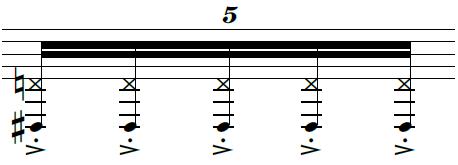
Clarinets
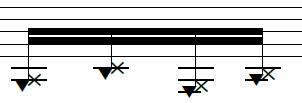
Key clicks and tongue ram, for percussive effect. The upper notehead (x) indicates the key click, the lower note is the sounding pitch/color effect. Abbreviated k.cl.t.r.
Key clicks and slap tongue, for percussive effect. The upper notehead (x) indicates the key click, the lower note indicates the low percussive slap effect. Abbreviated k.cl.sl.t.
Cor Anglais and Bassoons
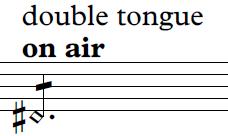
Brass
Double tongue on air. Play through the fundamental pitch given but aim at having a primarily airy sound with as little pitch as possible. Abbreviated d.t. on air.
When notes are slurred throughout an extended period of time and during long phrases without rest, breathe where necessary – not synchronised between performers.

Diamond noteheads indicate air sounds with no pitches sounding – airy noteheads are placed on the centre line of the staff, but should not produce any pitch.
When indicated to “perform on air with no pitch – with subtle ‘s’ sound formation for a subtly distorted sound on air” this should produce a subtle ‘white noise’ sound. Brass performers might prefer to remove the mouthpiece and perform this effect straight into the instrument where possible – explore for the best way to perform the sound for a subtle white noise and synchronize in technique between all performers. In these textures, as always, breathe where necessary – not synchronized.

Tongue flicks on air, written in rhythmic patterns (as a controlled flutter) – please approach this technique as an atmospheric breath.
Dynamics on airy notes are relative to the sound of the effect, so they should be aimed at projecting relative to the nuance of the sound rather than in the same dynamic as a pitch with the same dynamics would. It is asked that the ethereal airy textural effects should not be overemphasised or overdramatised – the airy sounds are intended to be a textural dimension to the overall sound texture – that at times gets overshadowed by other textures – rather than to be an overly prominent feature. “Soft mute” – when indicated please choose a mute that has as much as possible a soft and warm sound.
Percussion
All Bass Drums need to be placed horizontally in order to be able to perform with objects on the skin. Allow resonance of instruments to continue and do not stop or dampen unless otherwise indicated.
Staff notation
Large Thunder Sheet
Large Tam-tam
Large Bass Drum
ISSUU version for perusal only
Objects needed for each percussionist
Small bundle of loose dried eucalyptus leaves (approximately 10-12 large leaves per percussionist) to place on skin of bass drums. Thick cloth or felt to mute the edge of the bass drum. When indicated, place the cloth on the rim of the bass drum and play with the side of a drum stick on the rim with the cloth in-between. The desired effect is a muted short attack.
^ Large soft bass drum mallet (two each)
• Wire brush mallet (two each)
® Superball mallet (two each)
Ж Double Bass bow (one each)
¶ Drum stick (two each)
Techniques


Circular strokes on surface as indicated (example shown is a dotted half-note).
Sustain with hands in circular strokes on skin of bass drum as indicated, simultaneously with both hands in continuous strokes for an airy “breathing” effect. When indicated with “occasionally with fingernails” on occasion draw fingernails over skin for a slight change to the sound.
When “circular strokes with hands on skin” is indicated while dried leaves are placed on skin of the drum, organically direct the movements between moving hands on skin around the leaves, and on occasion sliding the leaves over the skin.

When written with “regular” mallets, refers to playing rolls (rather than rhythmic 32nd notes).

Indicates short attacks on surface as written on each occasion.
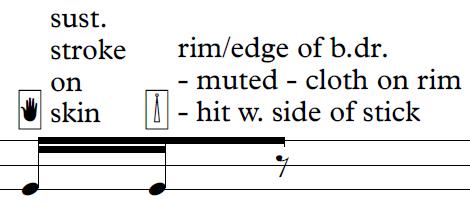
This patterns appears in Part II in unison on the fourth beat in all woodwinds and percussion. The repetition of this pattern should produce an atmospheric sense of looping, a sense of leading to the first beat of the following bar(s) –to the materials played by others in the orchestra.
When bowing on the edge of tam-tam and thunder sheet, please aim for an ethereal sound as much as possible by releasing bow pressure as needed so that the sound does not become too scratchy or squeaky please.
Solo Cello
* every note has a full presence *
Please approach all extended techniques from the point of view of extra musicality – all effects are written as expressive means to produce sounds that, even though may not carry pitches, are deeply musical and carry an expression within my musical language. During long sustained notes please change bow as needed – it is not intended for bow strokes to be too slow but rather of the required speed each time for the tone to be fully carried with depth and fundament.
Special noteheads and effects

Place left hand (not only one finger) lightly to cover the indicated string, around the given pitch area, not on harmonic. Fingers are not to be placed on exact pitches. This produces an unpitched airy sound. The lower small notehead indicates the open string to be performed on, the upper notehead indicates the approximate position of the hand.
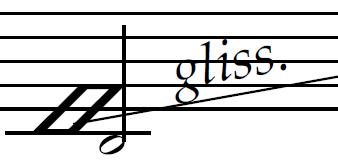
When the airy notehead is written with a glissando, slide the hand up or down the string as indicated. This will produce slight harmonic colours in the airy sound as the hand glissandos over the string(s), but the aim is for the sound to be as pitchless as possible.
When indicated with tremolo lines, play ordinary tremolo on the airy sound.

Much bow pressure performed on muted string, not on a pitch (as indicated by the notehead). When written on a short note value (sixteenth note) this should produce a non-pitched percussive attack to the muted string. The short notes on much bow pressure work best when performed close to the frog.

When indicated to play with ‘much bow pressure’ on a longer sustained note – apply a bit more (than ordinary) bow pressure to the string for a subtle atmospheric sustained distortion sound through continued movement of the bow. Not so much bow pressure that the flow of the bow is disturbed or that the sound becomes too aggressive or too scratchy, but rather subtly distorted sustained sounds, similar to white noise. When indicated 'subtly m.b.pr.', apply slight over pressure, but not too much, for a slight distortion effect.
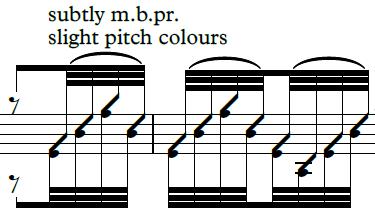
When indicated to perform airy noteheads in arpeggio patterns between strings, keep fingers/hand on strings and articulate “on air” – subtle pitch colours will naturally appear through the airy sound.
When airy/muted noteheads are indicated with ord., it refers to playing normally on the written effect and merely serves to take back other indications such as sul pont., much bow pressure etc. When performing on air with ordinary bow pressure it should result in an airy sound.
Dynamics on airy notes are relative to the sound of the effect, so they should be aimed at projecting relative to the nuance of the sound rather than in the same dynamic as a pitch with the same dynamics would.
ISSUU version for perusal only
Col legno saltando battuto – when written on particular pitches the pitch comes through, when written on muted string the effect should be a pitchless attack.
There are two versions of accelerando on airy textures:

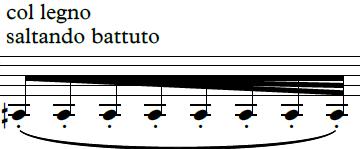
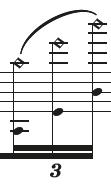
Bow strokes back and forth as indicated in an accelerating motion.
Hitting the string with the bow bouncing on the string in an accelerating motion.
Natural harmonics – played at the position indicated by the diamond note head on the string indicated. The small lower note head above indicates the string, the diamond note head indicates the sounding pitch.
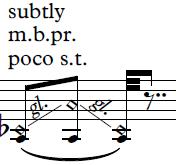
Quick glissando over the harmonics on the indicated string with slight over-pressure.

Atmospherically moving between these techniques.

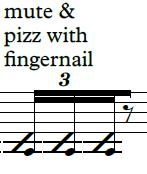
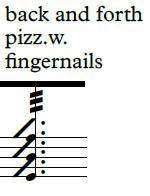

When the irregular pattern lines are written below the notes, it indicates to draw the bow vertically up and down on the string(s) in various shapes and circles at various speeds throughout the duration of the note value. With tremolo (as shown here) make vertical tremolo strokes (up and down) on the string. These lines apply to the whole duration of the note values that they are written under.
When indicated to 'mute & pizz with fingernail', mute string with finger/hand and sharply pizz. with fingernail in a tiny movement very close to the muted point, for a rhythmic – unpitched – crackling sound. This should result in low resonance rhythmic attacks.
Tremolo with fingernails on muted strings.
Wide vibrato – example:
Quartertones
B Quar ter tone flat
I Quar ter tone flat below b
µ Quar ter tone sharp
˜ Quar ter tone sharp above #
Abbreviations
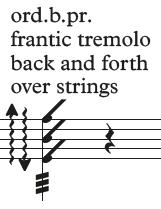
Tremolo on muted strings – moving between two muted str ings at (G-D and D-A).
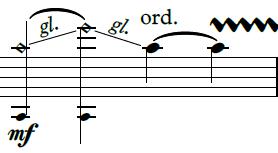
ord. – ordinary, takes back all effects previously applied, including (but not limited to) sul pont.
l.b.pr. – light bow pressure: apply light bow pressure to the string for an airy effect resulting in a light and transparent sound, flautando m.b.pr. – much bow pressure: apply a bit more (than ordinary) bow pressure to the string for a subtle atmospheric sustained distortion sound through continued movement of the bow. Not so much bow pressure that the flow of the bow is disturbed or that the sound becomes too aggressive.
ord.b.pr. – ordinary bow pressure
ord.b.str. – ordinary bow stroke
w. – with
String Section
Double basses need to have pitch extension down to C or tune the E string down to C. When notes are slurred through an extended period of time – change bow where necessary.
Written effects, such as flautando or sul pont. are applicable until recalled with ord. After a substantial silence the effect may be indicated again if applicable for following phrase(s) for clarity.
ISSUU version for perusal only
Please approach all extended techniques from the point of view of extra musicality – all effects are written as expressive means to produce sounds that, even though may not carry pitches, are deeply musical and carry an expression within my musical language. They are intended to sound as one with the harmonies and pitched materials rather than being overly exaggerated as “other”.
Bow Strokes
When notes are tied through an extended period of time – change bow where necessary. During long sustained notes please change bow as often as necessary, not synchronised, it is not intended for bow strokes to be too slow but rather of the required speed each time for the tone to be fully carried with depth and fundament.
Vibrato
In lyrical and “expressive” passages please apply vibrato. In other passages, collectively apply vibrato as desired.
During glissandos and harmonics please play senza vibrato.
Special noteheads and effects

(example from the viola part, quarter note and eighth note shown) for airy effect – place left hand/fingers (not only one finger) lightly to cover the indicated string, around the given pitch area, not on harmonic. Fingers are not to be placed on exact pitches. This produces an unpitched airy sound. The upper notehead indicates the airy technique, the small notehead below indicates the open string where the technique is to be played.

(example from the violin part, tremolo quarter notes shown): when the airy notehead is written with a glissando, slide the hand down/up the string as indicated. This will produce slight harmonic colours in the airy sound as the hand glissandos over the string(s), but the aim is for the sound to be as pitchless as possible.
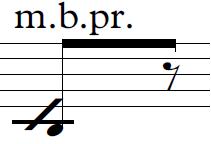

Much bow pressure performed on muted string, not on a pitch (as indicated by the notehead). When written on a short note value (sixteenth note) this should produce a non-pitched percussive attack to the muted string. The short notes on much bow pressure work best when performed close to the frog.
When indicated to play with ‘much bow pressure’ on a longer sustained note – apply a bit more (than ordinary) bow pressure to the string for a subtle atmospheric sustained distortion sound through continued movement of the bow. Not so much bow pressure that the flow of the bow is disturbed or that the sound becomes too aggressive or too scratchy, but rather subtly distorted sustained sounds, similar to white noise.

When indicated to perform airy noteheads in arpeggio patterns between strings, keep fingers/hand on strings and articulate “on air” – subtle pitch colours will naturally appear through the airy sound.
When airy/muted noteheads are indicated with ord., it refers to playing normally on the written effect and merely serves to take back indication of otherwise performing such as with sul pont., much bow pressure etc. When performing on air with ordinary bow pressure it should result in an airy sound.
Dynamics on airy notes are relative to the sound of the effect, so they should be aimed at projecting relative to the nuance of the sound rather than in the same dynamic as a pitch with the same dynamics would.
Col legno saltando battuto – when written on particular pitches the pitch comes through, when written on muted string the effect should be a pitchless attack.
There are two versions of accelerando on airy textures:




Bow strokes back and forth as indicated in an accelerating motion.
Hitting the string with bow hairs and having the bow bounce on the string in an accelerating motion.
There are two types of glissando on harmonics: ordinary glissando from one pitch to the next and, when indicated to ‘hold position of hand’ (hold pos. of hand for short) glissando on the indicated string while holding the position of the hand. The latter results in ghostly effect of various harmonics as the fingers slide down the string.
(appears in cellos, basses and solo strings): quick glissando over T he same effect landing the harmonics on the indicated string with slight over-pressure. on an ord. pitch.


(appears in solo strings): when the irregular pattern lines are written below the notes, it indicates to draw the bow vertically up and down on the string(s) in various shapes and circles at various speeds throughout the duration of the note value. With tremolo make vertical tremolo strokes (up and down) on the string. These lines apply to the whole duration of the note values that they are written under.
Quartertones
B Quar ter tone flat
I Quar ter tone flat below b
µ Quar ter tone sharp
˜ Quar ter tone sharp above #
Abbreviations
ISSUU version for perusal only
ord. – ordinary, takes back all effects previously applied, including (but not limited to) sul pont.
l.b.pr. – light bow pressure: apply light bow pressure to the string for an airy effect resulting in a light and transparent sound, flautando
m.b.pr. – much bow pressure: apply a bit more (than ordinary) bow pressure to the string for a subtle atmospheric sustained distortion sound through continued movement of the bow. Not so much bow pressure that the flow of the bow is disturbed or that the sound becomes too aggressive.
ord.b.pr. – ordinary bow pressure sust. – sustained
b.str. – bow stroke vib. – vibrato
w. – with
s.p. – sul pont.
c.l. – col legno
salt. batt. – saltando battuto
ISSUU version for perusal only

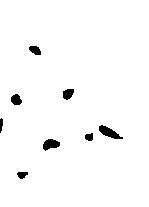
ISSUU version for perusal only
thundersheetandtam-tam








ISSUU version for perusal only
ISSUU version for perusal only
ISSUU version for perusal only
ISSUU version for perusal only
ISSUU version for perusal only
ISSUU version for perusal only
ISSUU version for perusal only
ISSUU version for perusal only
ISSUU version for perusal only

ISSUU version for perusal only
ISSUU version for perusal only
ISSUU version for perusal only
inconspicuouslyplacedriedeucalyptusleavesonskinofbassdrum
ISSUU version for perusal only

ISSUU version for perusal only

ISSUU version for perusal only



